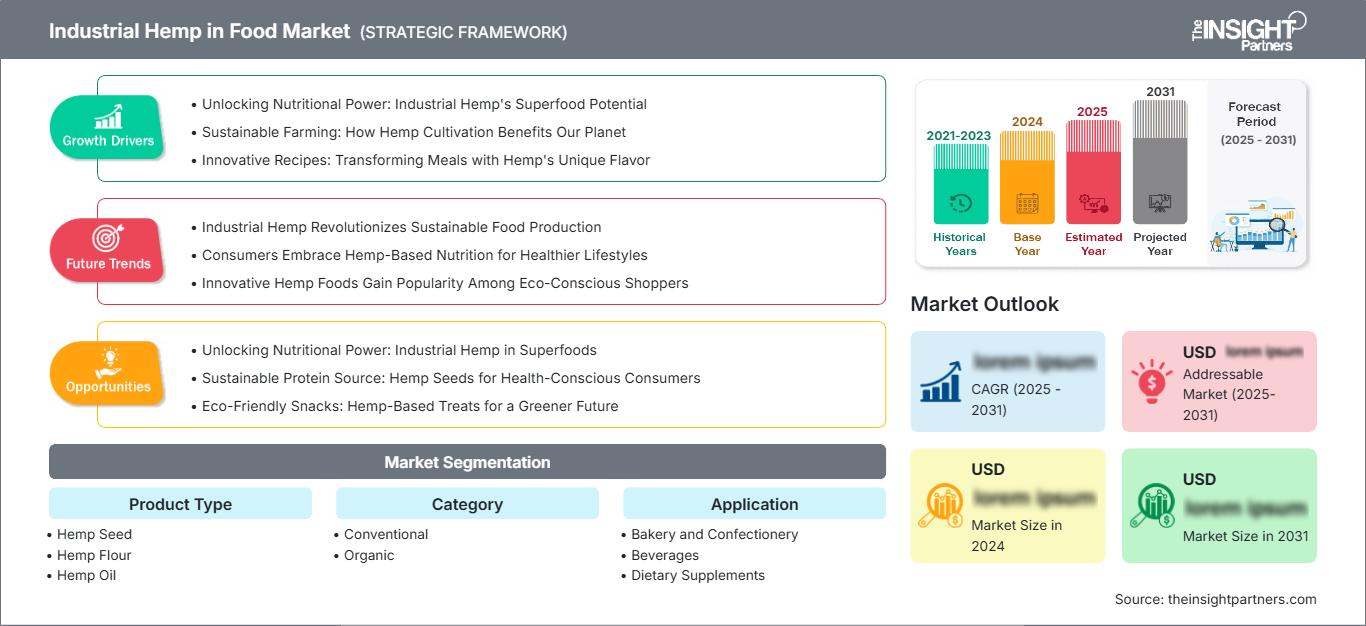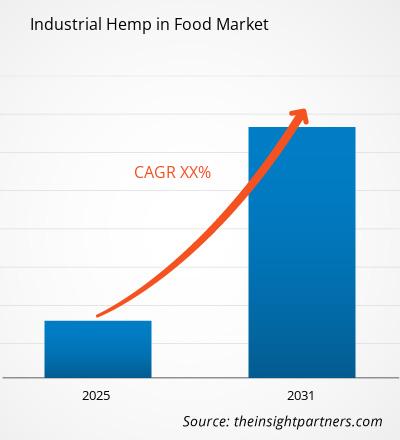Se prevé que el Cáñamo Industrial en el Mercado Alimentario registre un crecimiento constante de 2026 a 2034, con una valoración que crezca desde la línea base de 2025 y avance hacia una expansión sostenida hasta el final del periodo de previsión. Esta tendencia refleja una perspectiva favorable del mercado impulsada por la evolución de los requisitos de la industria y los continuos avances tecnológicos.
El informe se categoriza por tipo de producto (semilla de cáñamo, harina de cáñamo, aceite de cáñamo, proteína de cáñamo) y analiza el mercado según la categoría (convencional, ecológico). También examina el mercado por aplicación (panadería y confitería, bebidas, suplementos dietéticos, aperitivos dulces y salados). Se ofrece un desglose exhaustivo a nivel global, regional y por país para cada uno de estos segmentos clave.
El informe incluye el tamaño del mercado y las previsiones en todos los segmentos, presentando valores en USD. También ofrece estadísticas clave sobre el estado actual del mercado de los principales actores, junto con información sobre las tendencias predominantes y las oportunidades emergentes.
Propósito del informe
El informe Industrial Hemp in Food Market de The Insight Partners pretende describir el panorama actual y el crecimiento futuro, los principales factores impulsores, los desafíos y las oportunidades. Esto proporcionará información a diversos actores empresariales, como:
- Proveedores de tecnología/fabricantes: Para comprender la dinámica cambiante del mercado y conocer las posibles oportunidades de crecimiento, permitiéndoles tomar decisiones estratégicas informadas.
- Inversores: Realizar un análisis exhaustivo de tendencias sobre la tasa de crecimiento del mercado, las proyecciones financieras y las oportunidades que existen a lo largo de la cadena de valor.
- Organismos reguladores: Regular las políticas y vigilar las actividades en el mercado con el objetivo de minimizar el abuso, preservar la confianza y la confianza de los inversores, y mantener la integridad y estabilidad del mercado.
Segmentación del cáñamo industrial en el mercado alimentario Tipo de producto
- Semilla
- de cáñamo Harinade cáñamo
- Aceite de cáñamo
- Categoría de proteína
- de cáñamo Aplicación orgánica
- convencional Panadería y dulcería
- Bebidas
- Suplementos dietéticos
- Aperitivos dulces y salados
Disfrutará de la personalización gratuita de cualquier informe, incluyendo partes del mismo, análisis por país y un paquete de datos de Excel. Además, podrá aprovechar excelentes ofertas y descuentos para startups y universidades.
El cáñamo industrial en el mercado alimentario: Perspectivas estratégicas

-
Obtenga las principales tendencias clave del mercado de este informe.Esta muestra GRATUITA incluye análisis de datos, desde tendencias del mercado hasta estimaciones y pronósticos.
Impulsores del crecimiento del cáñamo industrial en el mercado alimentario
- Desbloqueando el poder nutricional: El potencial del cáñamo industrial como superalimento
- Agricultura sostenible: Cómo el cultivo de cáñamo beneficia a nuestro planeta
- Recetas innovadoras: Transformando comidas con el sabor único del cáñamo
Tendencias futuras del cáñamo industrial en el mercado alimentario
- El cáñamo industrial revoluciona la producción sostenible de alimentos
- Los consumidores adoptan la nutrición basada en cáñamo para estilos de vida más saludables
- Los alimentos innovadores de cáñamo ganan popularidad entre los compradores con conciencia ecológica
Oportunidades del cáñamo industrial en el mercado alimentario
- Desbloqueando el poder nutricional: El cáñamo industrial en superalimentos
- Fuente de proteína sostenible: Semillas de cáñamo para consumidores conscientes de la salud Snacks ecológicos: Delicias a base de cáñamo para un futuro más verde
El cáñamo industrial en el mercado alimentario
Los analistas de The Insight Partners han explicado detalladamente las tendencias regionales y los factores que influyen en el mercado del cáñamo industrial en alimentos durante el período de pronóstico. Esta sección también analiza los segmentos del mercado de gestión de enfermedades del ritmo cardíaco y la geografía en América del Norte, Europa, Asia Pacífico, Oriente Medio y África, y América del Sur y Central.
Alcance del informe sobre el mercado del cáñamo industrial en alimentos
By Categoría- Convencional
- Orgánica
- Panadería y Confitería
- Bebidas
- Suplementos Dietéticos
- Snacks Dulces y Salados
- Reino Unido
- Alemania
- Francia
- Rusia
- Italia
- Resto de Europa
- China
- India
- Japón
- Australia
- Resto de Asia-Pacífico
- Brasil
- Argentina
- Resto de América del Sur y Central
- Sudáfrica
- Arabia Saudita
- Emiratos Árabes Unidos
- Resto de Oriente Medio y África
Atributo del informe Detalles Tamaño del mercado en 2025 US$ XX Million Tamaño del mercado por 2034 US$ XX Million CAGR global (2026 - 2034) XX% Datos históricos 2021-2024 Período de pronóstico 2026-2034 Segmentos cubiertos By Tipo de producto - semilla de cáñamo
- harina de cáñamo
- aceite de cáñamo
- proteína de cáñamo
Regiones y países cubiertos Norteamérica - EE. UU.
- Canadá
- México
Líderes del mercado y perfiles de empresas clave - Ananda Food
- Badische Naturfaseraufbereitung GmbH (BaFa)
- Colorado Hemp Works, INC
- GenCanna
- Hemp Oil Canada
- Hempro International GmbH
- Konoplex
- MH medical hemp GmbH.
- Plains Industrial Hemp Processing Ltd.
Densidad de actores del mercado de cáñamo industrial en alimentos: comprensión de su impacto en la dinámica empresarial
El mercado del cáñamo industrial en la alimentación está creciendo rápidamente, impulsado por la creciente demanda del consumidor final debido a factores como la evolución de las preferencias de los consumidores, los avances tecnológicos y un mayor conocimiento de los beneficios del producto. A medida que aumenta la demanda, las empresas amplían su oferta, innovan para satisfacer las necesidades de los consumidores y aprovechan las tendencias emergentes, lo que impulsa aún más el crecimiento del mercado.

- Conseguir el El cáñamo industrial en el mercado alimentario Resumen de las principales jugadoras clave
Puntos Clave de Venta
- Cobertura Integral: El informe abarca el análisis exhaustivo de productos, servicios, tipos y usuarios finales del mercado del cáñamo industrial en alimentos, ofreciendo un panorama holístico.
- Análisis de Expertos: El informe se elabora con base en el profundo conocimiento de expertos y analistas de la industria.
- Información Actualizada: El informe garantiza relevancia comercial gracias a su cobertura de información y tendencias de datos recientes.
- Opciones de Personalización: Este informe se puede personalizar para satisfacer las necesidades específicas del cliente y adaptarse a las estrategias comerciales.
Por lo tanto, el informe de investigación sobre el mercado del cáñamo industrial en alimentos puede ayudar a liderar el camino para decodificar y comprender el escenario de la industria y las perspectivas de crecimiento. Si bien puede haber algunas preocupaciones válidas, los beneficios generales de este informe tienden a superar las desventajas.
- Análisis histórico (2 años), año base, pronóstico (7 años) con CAGR
- Análisis PEST y FODA
- Tamaño del mercado, valor/volumen: global, regional y nacional
- Industria y panorama competitivo
- Conjunto de datos de Excel
Informes recientes
Informes relacionados
Testimonios
Razón para comprar
- Toma de decisiones informada
- Comprensión de la dinámica del mercado
- Análisis competitivo
- Información sobre clientes
- Pronósticos del mercado
- Mitigación de riesgos
- Planificación estratégica
- Justificación de la inversión
- Identificación de mercados emergentes
- Mejora de las estrategias de marketing
- Impulso de la eficiencia operativa
- Alineación con las tendencias regulatorias






















 Obtenga una muestra gratuita para - El cáñamo industrial en el mercado alimentario
Obtenga una muestra gratuita para - El cáñamo industrial en el mercado alimentario